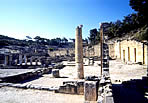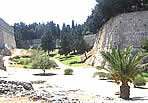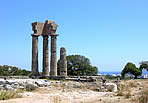Rhodes Acts 21:1
The largest island of the Dodecanese (48 miles long, 23 miles
wide) houses nearly 100,000 inhabitants today (and scores of
tourists). Rhodes (or Rodos) has become the regional capital of the
Dodecanese islands. The highest point of the island is Mt. Ataviros
(at 125 m ASL) in the center of the island. The island is fertile
with a great variety of vegetation. In antiquity the island bore 11
different names, among them: Aithraia, Ophiousa and Telchinis. The
capital, also called Rhodos, occupies the northernmost tip of the
island.
Rhodes (probably form "rose" in Greek) has a long and important
history. The island was first inhabited in the Neolithic era. During
the Bronze Age (3000-1150 BCE) three early c ities
were formed on the island: Kamiros (west), Lindos (east) and Ialysos
(Near Filermos in north, not far from Rhodos city). The wares have
been discovered at excavations in both Egypt and Italy. The island
traded gold jewelry and ceramics decorated with oriental motifs or
plants and animals in stylised form. Through the Greek Dark Age
(1150-800 BCE) Rhodes was recalled in mythology (Pindar in one of
his Odes) as the island of Helios (the sun god) - born of the union
of Helios the sun god and the nymph Rhodia. By the Archaic Period
(800-500 BCE) the Dorian invasion caused displacement of people
groups in the Aegean. Rhodes was included in the formation (700 BCE)
of the "Dorian Hexapolis" a union of cities with Knidos,
Halikarnassos and Kos. It was home to Epimenedes the poet (600 BCE).
ities
were formed on the island: Kamiros (west), Lindos (east) and Ialysos
(Near Filermos in north, not far from Rhodos city). The wares have
been discovered at excavations in both Egypt and Italy. The island
traded gold jewelry and ceramics decorated with oriental motifs or
plants and animals in stylised form. Through the Greek Dark Age
(1150-800 BCE) Rhodes was recalled in mythology (Pindar in one of
his Odes) as the island of Helios (the sun god) - born of the union
of Helios the sun god and the nymph Rhodia. By the Archaic Period
(800-500 BCE) the Dorian invasion caused displacement of people
groups in the Aegean. Rhodes was included in the formation (700 BCE)
of the "Dorian Hexapolis" a union of cities with Knidos,
Halikarnassos and Kos. It was home to Epimenedes the poet (600 BCE).
During the Classical Period (500-336 BCE) the Persians occupied the
island for a brief time, but the Admiral Mentalos of Rhodes
eventually routed them. In 408 BCE, the three chief cities of the
island founded Rhodos city, which quickly outgrew them. The city was
built under the plan of Hippodamos of Miletos and the league was
wisely administered under tyrants, and prosperity in creased,
for a time finding themselves under Spartan rule.
creased,
for a time finding themselves under Spartan rule.
In the period of Alexander and Diadoche (336-43 BCE) the rising
tensions in the region forced great investment into a maritime fleet
and produced protection and far-reaching prosperity. Rhodes was
independent from 327 BCE when the Macedonian guard was removed and
concentrated on an effective port, maritime law, and rescue service
on the seas. A school of sculpture was developed and exported works
abroad (Colossus of Rhodes* by Chares of Lindos - one of the seven
"wonders of the world"; the "victory of Samothrace by Pythekritos;
and Laocoon - now in the Vatican). The island was attacked in 304
BCE unsuccessfully, but had to recover from an earthquake in 277
BCE. By 200 BCE, it was a regular stop for the Roman fleet. [*The
Colossus was probably built at 100 to 150 feet high in 302-290 BCE,
but fell into the harbor during an earthquake in about 226 BCE, and
was finally scrapped in 657 CE.]
The Roman Period (43 BCE-300 CE) brought destruction and
reconstruction. Rhodes was not always constant in its loyalty to
Rome. When opposed Rome, Rome retaliated by offering additional
funding to Delos as a port (166 BCE) giving mainland Caria and Lycia
an alternative port for trad e.
This crushed Rhodes economically and forced her to ally herself to
Rome. In one raid, Gaius Cassius captured and laid waste to the city
of Rhodes (now the capital). St. Paul harbored there (though most
believe at Lindos) in about 57 CE (Acts 21:1). There is no record of
any missionary work by St. Paul on this island. By that time Rhodes
had diminished considerably to a small port but retained its beauty
and marks of former prosperity as well as some important schools.
Great Roman students taught on the island included Cicero, Lucretius,
Julius Caesar, Tiberius Caesar and Marc Antony. Diocletian declared
it a province in 297 CE.
e.
This crushed Rhodes economically and forced her to ally herself to
Rome. In one raid, Gaius Cassius captured and laid waste to the city
of Rhodes (now the capital). St. Paul harbored there (though most
believe at Lindos) in about 57 CE (Acts 21:1). There is no record of
any missionary work by St. Paul on this island. By that time Rhodes
had diminished considerably to a small port but retained its beauty
and marks of former prosperity as well as some important schools.
Great Roman students taught on the island included Cicero, Lucretius,
Julius Caesar, Tiberius Caesar and Marc Antony. Diocletian declared
it a province in 297 CE.
Much later, the Crusader Period (1000-1450 CE) brought a period of
stability (and building) to the island. In 1309 it fell into the
hands of the Knights of St. John and became again a maritime power -
symbolized by its magnificent medieval town and castle with the
Palace of the Grand Masters. This period lasted until the fall under
Sulieman II in 1522 CE. The buildings of the period mimic the
buildings of Avignon, France. Likely this period also saw the
creation of the Rhodes faience (brilliant enamels on ceramic plates
probably originated in Lindos - or borrowed technology from Nicea).
from Nicea).
In the Modern Period (1830-present) the island was taken in 1911 by
the Italians (from the Turks) and they annexed it to protect the
route to African colonies. They were responsible for much of the
restoration on the island seen today. It was occupied by Germans
from 1943-45, taken by the British, and made part of Greece on 7
March 1948.
PLACE
REFERENCE
Amphipolis
Acts 17:1
Apollonia
Acts 17:1
Athens
Acts 17:15-16, 22; 18:1; 1 Thessalonians 3:1
Berea
Acts 17:10, 13: 20:4
Cenchrea
Acts 18:18, Romans 16:1
Coos (Kos)
Acts 21:1
Corinth
Acts 18:1; 19:1; 1 Corinthians 1:2; 2 Corinthians 1:1, 23; 2 Timothy
4:20
Cyprus
Acts 4:38; 11:19,20; 13:4; 15:39; 21:3,16; 27:4
Neapolis (Kavala) Acts 16:11
Patmos
Rev 1:9
Philippi Matthew 16:13; Mark 8:27; Acts 16:12, 22;
20:6; Philippians 1-4; 1 Thessalonians 2:2
Rhodes
Act 21:1
Thessalonica Acts
17:1. 11. 13; 27:2; Philippians 4:16: 1 and 2 Thessalonians; 2
Timothy 4:10


